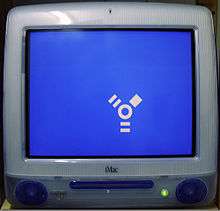Target Disk Mode

Target Disk Mode (sometimes referred to as TDM or Target Mode) is a boot mode unique to Macintosh computers.
When a Mac that supports Target Disk Mode[1] is started with the 'T' key held down, its operating system does not boot. Instead, the Mac's firmware enables its drives to behave as a SCSI, FireWire, Thunderbolt and/or USB-C external mass storage device.
A Mac booted in Target Mode can be attached to the port of any other computer - Mac or PC - where it will appear as an external device. Hard drives within the target Mac, for example, can be formatted, partitioned, etc., exactly like any other external drive. Some computers will also make their internal CD/DVD drives and other internal and external peripheral hardware available to the host computer.[2]
Target Disk Mode is useful for accessing the contents of a Mac which cannot be booted from its own operating system. Target Disk Mode is the preferred form of old-computer to new-computer interconnect used by Apple's Migration Assistant. Migration Assistant supports Ethernet (wired) or Wi-Fi, which TDM does not. Neither supports USB; however, Thunderbolt->Firewire, Thunderbolt->Gigabit Ethernet and USB 3.0 -> Gigabit Ethernet adapters are an option when one of the computers does not have Firewire or Thunderbolt.
History
Apple introduced disk mode access with the original PowerBook 100 and continued to offer it with most subsequent PowerBook series and FireWire-equipped Macs. As long as the requisite software appeared in the system ROM, the Mac could be booted into disk mode.
Originally called SCSI Disk Mode, a special cable (SCSI System Cable) allowed the original PowerBook series to attach to a desktop Mac as an external SCSI disk. A unique system control panel on the PowerBook was used to select a non-conflicting SCSI ID number from the host Mac. This also made it possible to select the disk in the Startup control panel and boot up from it.
With the change to IDE drives starting with the PowerBook 150 and 190, Apple implemented HD Target Mode, which essentially enabled SCSI Disk Mode by translating the external SCSI commands via the ATA driver. Officially reserved for Apple's portables only, all PowerBooks exclusively supported disk mode except the 140, 145, 145B, 150 and 170. However, SCSI Disk Mode can be implemented unofficially on any Macintosh with an external SCSI port, by suspending the startup process with the interrupt switch, as long as all internal drives on the chain can be set to different IDs than the active host system's devices.
When Apple dropped the SCSI interface, starting with the AGP Power Mac G4 and “Pismo” PowerBook G3 FireWire Target Disk mode replaced the earlier disk mode implementation, also receiving official support beyond laptops to all subsequent Macs with built-in Firewire.
Thunderbolt supports Target Disk Mode.[3][4]
The 12-inch Retina MacBook (early 2015) has only one expansion port, a USB-C port that supports charging, external displays, and Target Disk Mode. Using Target Disk Mode on this MacBook requires a cable that supports USB 3.0 or USB 3.1, with either a USB-A or USB-C connector on one end and a USB-C connector on the other end for the MacBook.[5]
System requirements
The target computer (the computer to be placed into TDM) must have:
- A FireWire or Thunderbolt Port[6]
- An ATA device at ATA bus 0[7]
- Any Macintosh except the following models:
- iMac (Tray-Loading)
- Power Macintosh G3 (Blue & White) [8]
- iBook G3 models without FireWire
- Power Macintosh G4 (PCI Graphics) [9]
- MacBook Air (2008-2009)
- MacBook (Unibody)
The host computer (the computer into which the Target Disk Mode booted computer is plugged) merely needs to meet the same requirements as for any external mass storage device using the bus in question, and (if access to native Mac formatted partitions such as the boot volume is desired) support for the correct version of Hierarchical File System. On Classic Mac OS, this means FireWire 2.3.3 or later and Mac OS 8.6 or later are required to use a Firewire target.[1]
The host computer may run Microsoft Windows, but with some possible shortcomings: to read a Mac's HFS-formatted partitions, extra drivers such as MacDrive, TransMac, MacDisk, or HFSExplorer are necessary. Users also must ensure their computer possesses appropriate interface hardware in order to physically connect to a Mac in Target Mode. MacDrive also has a read-only option to prevent any accidental editing of the computer in Target Disk Mode; however, this mode cannot be set after an HFS/HFS+ disk is mounted. With the addition of HFS drivers into Apple's Bootcamp, it has also become possible for Macs running Windows to read (but not write) HFS partitions, without the purchase of software. Users have separated these drivers from the main Bootcamp install, and now also install on other Windows computers. Host computers running Linux are also able to read and write to a Mac's HFS or HFS+ formatted devices through Target Disk Mode. It is working out-of-the-box on most distributions as HFS+ support is part of the Linux kernel. However these filesystems cannot be checked for errors, so for shrinking or moving partitions it is preferred to use Mac OS.
See also
Notes
- 1 2 Apple Inc (16 January 2002). "Target Disk Mode". Apple Developer Connection. Retrieved 13 July 2007.
- ↑ Griffiths, Rob. "Borrow an optical drive from another Mac", "Macworld", March 27, 2007. (retrieved October 8, 2010)
- ↑ "Macbook Pro EFI Firmware Update 2.2". Apple. Retrieved 15 September 2011.
- ↑ Fleishman, Glenn. "Secrets of Thunderbolt and Lion". TidBITS. Retrieved 27 February 2011.
- ↑ https://support.apple.com/en-us/HT204360
- ↑ "Transfer files between two computers using target disk mode". Oct 31, 2013. Retrieved 2014-05-28.
- ↑ "FireWire Target Disk Mode: Target Computer Shuts Down at Startup". June 12, 2002. Retrieved 2012-05-22.
- ↑ "Blue and White Power Mac G3". January 5, 1999. Retrieved 2013-11-12.
- ↑ "Power Mac G4 (Yikes!)". August 31, 1999. Retrieved 2013-11-12.